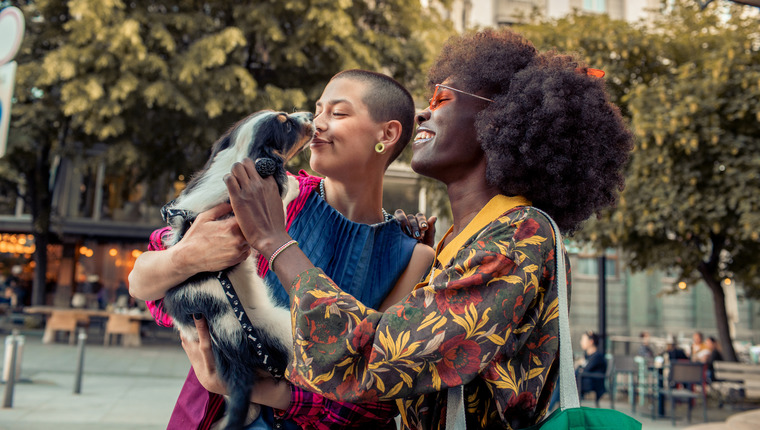
One partner is desperate for a dog while the other isn’t sure. It’s a tale as old as time.
Dogs can add so much fun and happiness into our lives, giving us companionship and affection. There’s a reason they’ve been such popular pets for so many years, after all. In fact, according to the American Veterinary Medical Association (AVMA), there are over 76 million pet dogs in the U.S. But, not everyone is too keen to adopt a dog, and there could be myriad potential reasons why.
You might be able to convince your partner, however. Of course, getting a dog is a major decision and you’ll both have to be on board – and there’s no guarantee you’ll turn them around. But, if you can assuage some of their concerns, you might change their mind. Read on to find out how.
Understanding your partner’s concerns
Whatever your partner’s concerns regarding getting a dog, do your best to understand them.
If your partner spends more time at home, or tends to wake up first or go to bed after you, they may be worried that they’ll be left with responsibilities like walking the dog.
They may be worried that a dog would damage the house or the yard – maybe they’ve got fragile ornaments or favorite plants. Or, financial concerns might be the main reason for them being unsure. It might be that they enjoy traveling and are worried about how a dog would fit in. Or, they might have misconceptions around how dogs behave with any children or other pets you may have. Perhaps they have allergies, and they’re concerned that having a dog would exacerbate them.
You might not agree, but respect their concerns – and consider how you might be able to address them.
How to address your partner’s concerns
If they’re worried about being left with all the responsibility, try to show them that this won’t be happening. You might decide to take on additional responsibilities around the house, or create a walking schedule and stick to it, proving that you can fit walking a dog into your own routine. Reassure your partner that you will care for the dog, should you get one.
Of course, you can’t promise that a new dog won’t chew on or destroy something they shouldn’t, or that there won’t be an unexpected vet bill on occasion, but what you can do is work together to discover how you might be able to minimize the risk. For example, can you work out how to dog-proof your house to keep precious items out of their reach? And make sure you both know which foods, plants, and household items are harmful to dogs – this way, there’s a lower chance of any medical emergencies and costly vet bills.
When it comes to traveling, mention options like having your dog stay with dog-loving friends or relatives. Or, even taking your dog with you, depending on where you’ll be going. If your partner is worried about how a dog would get on with the pets you already have, explain how to socialize them properly. And, reassure them that you’ll only adopt a dog that can live with other animals. And it’s the same if you have children. Make it clear that you’ll supervise them together and will make sure your children behave properly around your new furry friend.
Can you come up with a compromise? For example, you might look at adopting a dog that’s completed obedience training if your partner is worried about behavior in the home. Or, agree to adopt a lower-energy breed or an older dog if high-energy dogs are one of your partner’s concerns. And, reassure your partner that if you have children, for example, a shelter or rescue would be unlikely to let you adopt a dog that wouldn’t be good with them – even if you wanted to!
Research breeds together before you adopt a dog
Perhaps your partner has only been around certain breeds before. But just because they don’t want a German Shepherd, that doesn’t mean they won’t fall in love with a Cocker Spaniel, for example. There’s so much variety when it comes to dogs, so why not research breeds together?
You can make things fun by watching dog shows or creating a Pinterest board of cute dogs. Or, simply look at different breeds online. The breeds you favor might differ from the ones your partner does. But, perhaps there’s a breed out there on which you see eye to eye.
Try to find the best dog breed for you and your partner. If your partner doesn’t want a dog who sheds a lot of hair or requires a lot of grooming, take that into account. Likewise, if your partner likes the flexibility of being able to leave the house as and when, a breed that doesn’t mind being left home alone would be more suitable. If your partner wants a dog that’s good with children or other pets, take this into account.
But remember, dogs are all individuals, and even members of the same breed can vary in personality and temperament. So, it’s still important to speak to the rescue or shelter and meet your potential new dog too.
Make a plan
Work together to create a plan so that you know you’ll both be on the same page if you get a dog. Discuss things like training, veterinary care, dog-sitting, and dog walking too. If time is a concern, there are apps you can use to find dog walkers, too.
Make sure you have a daily schedule for your dog, too – after all, dogs need routine. But ensure that it won’t interfere with your partner’s routine.
Adopt a dog
Be sure to adopt, don’t shop, if you’re planning on getting a dog. Head to shelters and rescues near you, or take a look at their websites. You just might find your dream pup.









